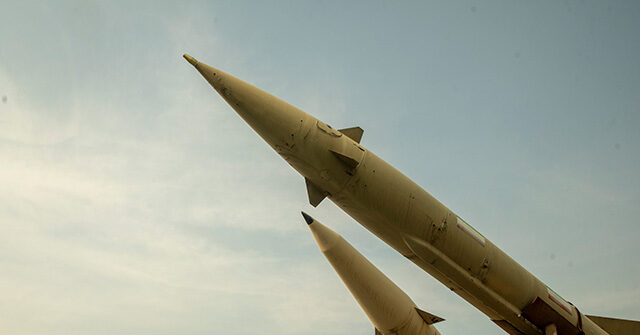Iranian Defense Minister Aziz Nasirzadeh said on Sunday that Iran has successfully tested an advanced solid-fueled ballistic missile that can penetrate the American-made Terminal High Altitude Area Defense (THAAD) anti-missile system and strike targets in Israel.
According to Nasirzadeh and Iranian state media, the new Qassem Basir missile is an upgrade of the old Martyr Hajj Qassem ballistic missile, which performed rather poorly during Iran’s two missile attacks on Israel last year.
Both the old and new versions of the missile are named after Iranian terrorist mastermind Gen. Qassem Soleimani, who was killed while plotting attacks against Americans in Iraq by an airstrike ordered by President Donald Trump in January 2020.
The Iranian regime has long claimed its missile strikes were actually highly effective and struck terror into the heart of Israel, despite reports that 99 percent of its weapons were intercepted before reaching their targets.
A member of the Iranian armed forces conducts an army orchestra as a truck carries a missile during a military parade as part of a ceremony marking the country’s annual army day in Tehran on April 17, 2024. (ATTA KENARE/AFP via Getty Images)
Nasirzadeh’s rollout of the new missile was something of a landmark in that he tacitly admitted the missiles Iran used in 2024 had some problems. He claimed “weaknesses” revealed during what Iran refers to as “Operation True Promise” have been corrected, so the Qassem Basir missile is now capable of getting past THAAD.
The Iranian defense minister claimed the new missile was successfully tested on April 17, when it ignored several decoys to accurately strike a target over 1,200 kilometers from its launcher.
WATCH — Trump Warns Iran: If You Attack Me, Your Country Gets “Blown to Smithereens”:
Iran unveiled the new missile on Sunday, the same day the Houthi terrorists of Yemen managed to slip a missile past U.S. and Israeli air defenses to land near Israel’s Ben Gurion Airport. The missile caused no fatalities and inflicted little damage, but it rattled Israelis who have grown accustomed to the high performance levels of their anti-missile systems.
The Israel Defense Forces (IDF) blamed the Ben Gurion incident on a “technical error,” but Iran clearly hoped to capitalize on the situation by implying it has created a new series of missiles that can duplicate the Houthis’ feat and strike Israeli targets at will. Iran has been supplying its Houthi clients weapons since before they drove the elected government of Yemen into exile in 2014.
Missile technology experts told Radio Free Europe (RFE) the Qassem Basir could be superior to previous Iranian long-range missiles in one important respect — the missile appears to use electro-optical (EO) guidance systems — which means it navigates visually, rather than being radio-guided. Iranian officials claim their electro-optical missiles do not require satellite navigational data to reach their targets.
This would theoretically make the missile difficult to neutralize with electronic warfare, which Israel used to great effect during Iran’s missile attacks in 2024. The Iranian Defense Ministry claimed the missile tested on April 17 was completely unaffected by intense electronic jamming.
Read the full article here


